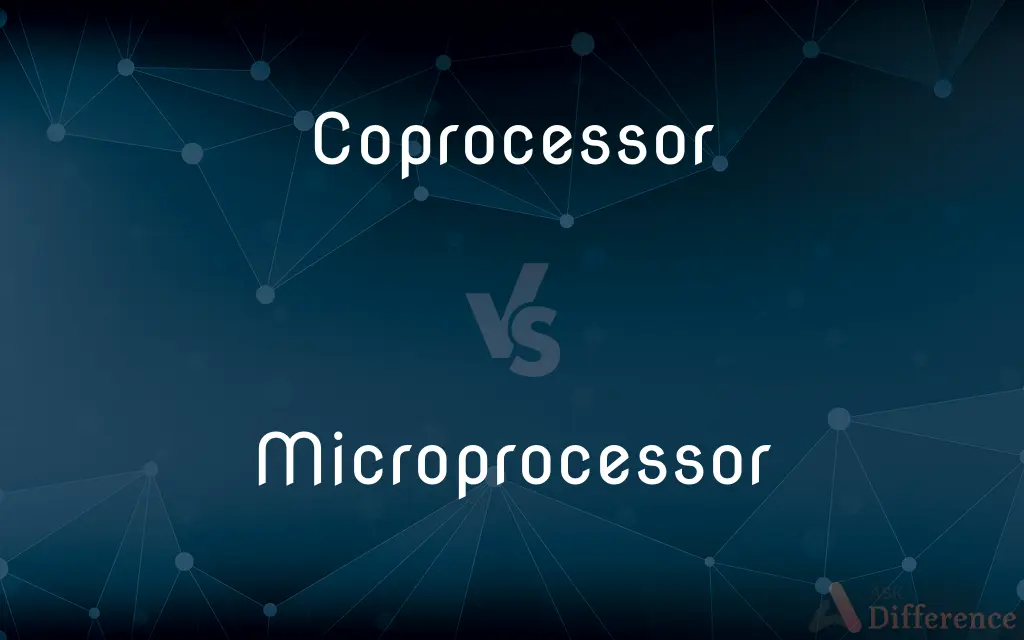Coprocessor vs. Microprocessor — What's the Difference?
By Fiza Rafique & Maham Liaqat — Updated on May 4, 2024
Coprocessors enhance a computer's performance by handling specific tasks like mathematical calculations, whereas microprocessors are central processors that execute a wide range of computer instructions.

Difference Between Coprocessor and Microprocessor
Table of Contents
ADVERTISEMENT
Key Differences
A coprocessor is designed to supplement the function of the primary microprocessor by taking over specialized processing tasks. This specialization often includes complex arithmetic or graphics rendering, aimed at improving system efficiency and performance. On the other hand, a microprocessor acts as the main processor of a computer system, executing general-purpose computing tasks and managing the overall operations of the system.
Coprocessors can significantly accelerate specific computations, such as floating-point operations, by offloading these tasks from the microprocessor. This allows the microprocessor to focus on other core system tasks, enhancing the multitasking capabilities of the system. In contrast, the microprocessor provides the necessary computational power to run everything from basic applications to the operating system itself.
Typically, coprocessors operate under the control of the main microprocessor, which delegates tasks to them as needed. This division of labor can greatly optimize the performance of computing systems that handle complex, resource-intensive tasks. Conversely, microprocessors are designed to be versatile and handle a broad spectrum of tasks independently, without the need for additional specialized support.
In modern computing, coprocessors are often integrated into the same chip as the microprocessor to form what is known as a multi-core processor. This integration helps streamline processing by reducing the physical and temporal distance between the main processor and its assistant. Microprocessors, however, continue to evolve, incorporating more cores and enhanced capabilities to handle a wider variety of tasks more efficiently.
Not all computing systems include coprocessors; their inclusion depends on the specific needs and tasks expected of the system. Whereas, every computer system is built around a microprocessor, making it an indispensable component of modern computing.
ADVERTISEMENT
Comparison Chart
Primary Function
Enhances processing capabilities
Executes primary computing instructions
Usage
Specialized tasks like graphics or math
General-purpose computing
Dependency
Works alongside a microprocessor
Operates independently
Integration
Often part of a larger CPU chip
Is the central unit in a CPU
Impact on System Performance
Increases efficiency for specific tasks
Essential for all computing activities
Compare with Definitions
Coprocessor
A hardware component that assists the microprocessor by performing specialized computations.
The graphics coprocessor accelerated the rendering of images in the video game.
Microprocessor
A central processing unit (CPU) that performs most of the computing tasks of a computer.
The microprocessor executed all major functions of the computer system.
Coprocessor
Often used in systems requiring high-speed processing of specific tasks.
Scientific calculators use a coprocessor for quick mathematical calculations.
Microprocessor
Operates independently of a coprocessor.
The microprocessor ran the operating system and applications without additional support.
Coprocessor
Can be integrated within the same chip as the microprocessor.
Modern CPUs integrate a coprocessor to enhance their multitasking capabilities.
Microprocessor
The fundamental component in modern computing devices.
Every computer, from laptops to smartphones, contains a microprocessor.
Coprocessor
Enhances system performance by handling complex tasks.
The floating-point coprocessor handled complex calculations, freeing the CPU to perform other tasks.
Microprocessor
Handles a variety of operations from simple to complex.
From running spreadsheets to playing games, the microprocessor managed all.
Coprocessor
Typically, does not replace the main microprocessor.
Despite the coprocessor's efficiency, the central processing was still managed by the main microprocessor.
Microprocessor
Can be designed with multiple cores to improve performance.
The quad-core microprocessor offered superior performance compared to its single-core counterparts.
Coprocessor
A coprocessor is a computer processor used to supplement the functions of the primary processor (the CPU). Operations performed by the coprocessor may be floating point arithmetic, graphics, signal processing, string processing, cryptography or I/O interfacing with peripheral devices.
Microprocessor
A microprocessor is a computer processor wherein the data processing logic and control is included on a single integrated circuit, or a small number of integrated circuits. The microprocessor contains the arithmetic, logic, and control circuitry required to perform the functions of a computer’s central processing unit.
Coprocessor
A microprocessor that performs specialized functions that the central processing unit cannot perform or cannot perform as well and as quickly.
Microprocessor
An integrated circuit that contains a major processing unit of a computer on a single microchip, such as the central processor or the graphics processor.
Coprocessor
(computer hardware) An additional microprocessor used to supplement the functionality of the central processing unit, performing tasks such as floating-point arithmetic (floating-point unit) or graphics calculations (graphics processing unit).
Microprocessor
(computer hardware) the entire CPU of a computer on a single integrated circuit (chip).
Microprocessor
Integrated circuit semiconductor chip that performs the bulk of the processing and controls the parts of a system;
A microprocessor functions as the central processing unit of a microcomputer
A disk drive contains a microprocessor to handle the internal functions of the drive
Common Curiosities
What is a coprocessor?
A coprocessor is a hardware component that enhances the processing capability of a computer by handling specific tasks like mathematical calculations or graphics processing.
Is a microprocessor necessary for a computer?
Yes, a microprocessor is essential as it serves as the core component that performs the majority of computing tasks.
Can a microprocessor work without any other processors?
Yes, a microprocessor can operate independently and manage all computer functions on its own, though additional processors like coprocessors can enhance performance for specific tasks.
How do coprocessors and microprocessors work together?
Coprocessors and microprocessors work together by having the microprocessor delegate specific, resource-intensive tasks to the coprocessor, thus freeing up resources and enhancing processing speed.
Can a computer function without a coprocessor?
Yes, a computer can function without a coprocessor, but having one can enhance performance for specialized tasks.
What tasks are typically handled by microprocessors?
Microprocessors handle a broad range of tasks including executing software applications, managing system operations, and processing data from various inputs.
What does a microprocessor do?
A microprocessor acts as the central processor of a computer, handling a wide range of tasks from executing applications to running the operating system.
How does a coprocessor improve system efficiency?
A coprocessor enhances system efficiency by handling specific types of tasks, allowing the microprocessor to allocate its resources to other operations, thus improving overall system performance.
What are common types of coprocessors?
Common types of coprocessors include math coprocessors, graphics coprocessors, and physics coprocessors, each designed to optimize specific functions within computing systems.
What happens if a system does not include a coprocessor?
If a system does not include a coprocessor, the microprocessor must handle all tasks, which can lead to decreased performance in systems that require intensive computational work.
How has the integration of coprocessors changed over time?
The integration of coprocessors has evolved from separate physical units to being incorporated directly onto the same chip as microprocessors, enhancing efficiency and speed by reducing the physical distance between processing units.
Are coprocessors found in all computing devices?
No, coprocessors are not found in all computing devices; they are typically included in systems where high efficiency for specific tasks, like graphics rendering or complex calculations, is crucial.
Share Your Discovery

Previous Comparison
Algorithm vs. Formula
Next Comparison
Dinosaur vs. DragonAuthor Spotlight
Written by
Fiza RafiqueFiza Rafique is a skilled content writer at AskDifference.com, where she meticulously refines and enhances written pieces. Drawing from her vast editorial expertise, Fiza ensures clarity, accuracy, and precision in every article. Passionate about language, she continually seeks to elevate the quality of content for readers worldwide.
Co-written by
Maham Liaqat















































